Plasma/Plasmoids/es: Difference between revisions
Created page with "La ventana del '''Notificador''' muestra una lista de todas las unidades conectadas de las que tenga conocimiento. Moviendo el ratón sobre una unidad mostrará cuantas posibles ..." |
Created page with "Haciendo clic en cualquier lugar del cuadro sombreado alrededor del nombre de la unidad (pero no en el icono para expulsar/desmontar si estuviera presente) se expande la entrada ..." |
||
| Line 17: | Line 17: | ||
La ventana del '''Notificador''' muestra una lista de todas las unidades conectadas de las que tenga conocimiento. Moviendo el ratón sobre una unidad mostrará cuantas posibles acciones hay asociadas con ese dispositivo. Si el dispositivo está montado, también habrá un pequeño icono a la derecha. Haciendo clic en él, hace que la unidad se desmonte y/o el medio se expulse. Ten en cuenta que desmontar/expulsar puede fallar si la unidad aún tiene archivos abiertos, por ejemplo: la copia de un gran archivo no ha finalizado. En la mayoría de los casos basta con esperar un momento y volverlo a intentar. | La ventana del '''Notificador''' muestra una lista de todas las unidades conectadas de las que tenga conocimiento. Moviendo el ratón sobre una unidad mostrará cuantas posibles acciones hay asociadas con ese dispositivo. Si el dispositivo está montado, también habrá un pequeño icono a la derecha. Haciendo clic en él, hace que la unidad se desmonte y/o el medio se expulse. Ten en cuenta que desmontar/expulsar puede fallar si la unidad aún tiene archivos abiertos, por ejemplo: la copia de un gran archivo no ha finalizado. En la mayoría de los casos basta con esperar un momento y volverlo a intentar. | ||
Haciendo clic en cualquier lugar del cuadro sombreado alrededor del nombre de la unidad (pero no en el icono para expulsar/desmontar si estuviera presente) se expande la entrada para mostrar la lista de posibles acciones para el dispositivo. Simplemente selecciona una y haz clic en OK o pulsa la tecla Enter. También puedes hacer doble clic. Para cerrar la ventana sin tomar ninguna acción, simplemente haz clic en el escritorio o en otra ventana, o pulsa <keycap>Esc</keycap>. | |||
===Weather Widgets=== | ===Weather Widgets=== | ||
Revision as of 11:20, 30 December 2010
Elementos gráficos de Plasma
Estos son algunos de nuestros favoritos. Otros elementos gráficos para Plasma están disponibles desde varias fuentes. Si necesitas ayuda para instalarlos, esta página te ayudará.
Elementos gráficos del sistema
Notificador de dispositivos
El Notificador de dispositivos se usa para gestionar dispositivos extraíbles como pendrives USB (también llamados unidades flash), cámaras digitales, discos duros externos USB, etc. También entra en juego cuando se inserta un medio como un CD o un DVD en una unidad óptica.
Cuando conectas un dispositivo externo, o cargas un nuevo medio en una unidad, la ventana del Notificador aparece (también puedes abrirla haciendo clic en su icono en el panel). Permanece abierta mientras el cursor está sobre ella, de lo contrario se cierra tras unos segundos.
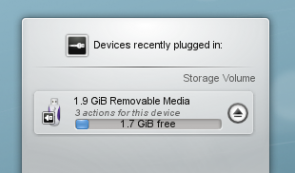
La ventana del Notificador muestra una lista de todas las unidades conectadas de las que tenga conocimiento. Moviendo el ratón sobre una unidad mostrará cuantas posibles acciones hay asociadas con ese dispositivo. Si el dispositivo está montado, también habrá un pequeño icono a la derecha. Haciendo clic en él, hace que la unidad se desmonte y/o el medio se expulse. Ten en cuenta que desmontar/expulsar puede fallar si la unidad aún tiene archivos abiertos, por ejemplo: la copia de un gran archivo no ha finalizado. En la mayoría de los casos basta con esperar un momento y volverlo a intentar.
Haciendo clic en cualquier lugar del cuadro sombreado alrededor del nombre de la unidad (pero no en el icono para expulsar/desmontar si estuviera presente) se expande la entrada para mostrar la lista de posibles acciones para el dispositivo. Simplemente selecciona una y haz clic en OK o pulsa la tecla Enter. También puedes hacer doble clic. Para cerrar la ventana sin tomar ninguna acción, simplemente haz clic en el escritorio o en otra ventana, o pulsa Esc.
Weather Widgets
Weather widgets are especially popular if you live in a country with very changeable weather, such as the U.K.
LCD Weather Widget
The LCD weather widget gets its information from one of three sources, the BBC weather from the UK Met. Office, NOAA's National Weather Service, or Environment Canada. If it can locate a weather station near you it will give you a range of details about the current weather.
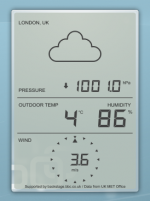
It can also be installed to the Task-bar, in which case you get an icon-size display which simply shows the current outside temperature.
Productivity Widgets
Pastebin Widget
This useful tool can be made quite small, to save desktop space, but is invaluable when you need to show a configuration file or screenshot which is too big to be accepted by email. It's also perfect for use with an IRC query.
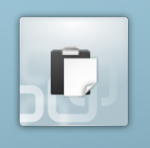 |
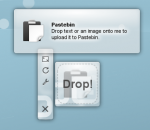
|
To use it, simply drag the required file onto the widget. The widget will then show 'Drop!'. When you drop your file it will give the URL for accessing it from the server, and can copy it to the clipboard for you. You can also drag images from other applications (such as KSnapshot, which is very handy for screenshots) or text that you have highlighted. You can also middle-click on the widget to send the currently selected text.
It uses both Pastebin and Imagebin servers and these are configurable via the widget's configuration dialog.
PowerDevil
A battery icon sits in your panel. According to your choice of configuration, it can display the remaining amount of charge, or display it when you hover over it. Click on the battery and you get the summary display, while clicking on the Configuration button ![]() takes you to a full configuration screen (click to view enlargement of images).
takes you to a full configuration screen (click to view enlargement of images).
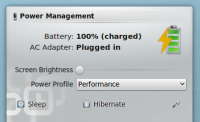 |
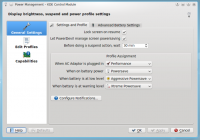 |
A further screen allows you to define and manage a number of profiles, and the final screen gives a summary of your computer or laptop's power-saving capabilities.
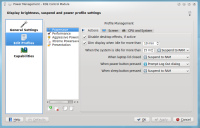 |
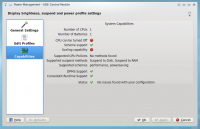 |
Finally, PowerDevil configurations can be set from Krunner, as described in detail here.
More information on configuration options can be found in this Fedora page.
![]() Support for this application can be found from the project's home page
Support for this application can be found from the project's home page
